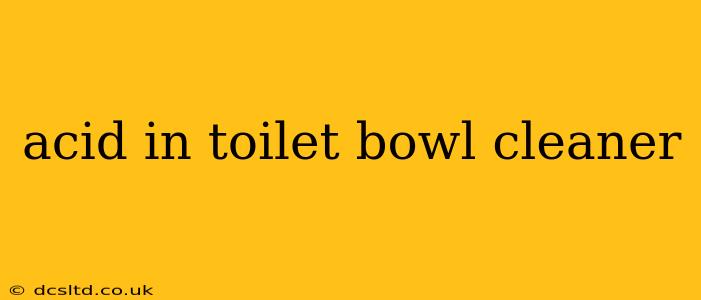Toilet bowl cleaners are designed to tackle tough stains and eliminate bacteria, and their effectiveness largely stems from the powerful acids they contain. Understanding these acids, their mechanisms of action, and safety precautions is crucial for both effective cleaning and personal safety. This article delves into the chemistry behind toilet bowl cleaners and provides essential information on safe usage.
What Acids are Commonly Used in Toilet Bowl Cleaners?
The most common acid found in toilet bowl cleaners is hydrochloric acid (HCl), also known as muriatic acid. This strong acid is highly effective at dissolving mineral deposits like limescale and rust, which often build up in toilets. However, its corrosive nature necessitates careful handling. Some cleaners also utilize sulfuric acid (H₂SO₄), another strong acid known for its ability to dissolve organic matter and minerals. While less frequently used than HCl in consumer products, its presence should be noted. Finally, some formulations might incorporate phosphoric acid (H₃PO₄), a weaker acid that is less corrosive but still effective at cleaning. The specific acid(s) used will vary depending on the brand and formulation of the toilet bowl cleaner.
How Do These Acids Clean a Toilet Bowl?
These acids work by chemically reacting with the mineral deposits and stains in your toilet bowl. The acid's protons (H⁺ ions) react with the mineral components, breaking down their structure and dissolving them into solution. For example, limescale, primarily calcium carbonate (CaCO₃), reacts with HCl to produce calcium chloride (CaCl₂), water (H₂O), and carbon dioxide (CO₂). This reaction effectively removes the limescale, leaving a cleaner bowl. The effectiveness depends on the concentration of the acid and the time it's in contact with the deposits.
Are There Different Types of Toilet Bowl Cleaners Based on Acid Type?
While the specific acid isn't always explicitly stated on the label, the type of toilet bowl cleaner often hints at the acid used. Gel cleaners, for instance, tend to use thicker formulations that may utilize phosphoric acid due to its lower corrosiveness compared to hydrochloric or sulfuric acid. Liquid cleaners are more frequently associated with stronger acids like HCl. However, the best way to know the precise acid used is by referring to the product's Safety Data Sheet (SDS), which manufacturers are obligated to provide.
What are the Safety Precautions When Using Acidic Toilet Bowl Cleaners?
Always read and follow the manufacturer's instructions carefully. This includes wearing appropriate safety gear, such as gloves and eye protection. Acidic toilet bowl cleaners can cause severe burns to the skin and eyes, and inhalation of the fumes can be harmful. Ensure adequate ventilation while using the cleaner. Never mix different cleaning products, especially those containing acids and bases (like bleach), as this can create dangerous chemical reactions. If accidental contact with skin or eyes occurs, immediately rinse the affected area with plenty of water for at least 15 minutes and seek medical attention. Keep toilet bowl cleaners out of reach of children and pets.
What are the Alternatives to Acidic Toilet Bowl Cleaners?
For those seeking gentler cleaning options, there are several alternatives. Many natural cleaners, like those utilizing vinegar (acetic acid, a much weaker acid) or baking soda, can effectively remove some stains and deodorize the toilet bowl. However, they may not be as effective as strong acids against heavy mineral deposits.
Is it Safe to Use Acidic Toilet Bowl Cleaners Regularly?
While effective, regular use of acidic toilet bowl cleaners can damage the porcelain over time. It's generally recommended to use them sparingly and only when necessary to address persistent stains or mineral buildup. Regular cleaning with milder methods can help prevent the need for frequent use of strong acid-based cleaners.
This information is for educational purposes only. Always consult the product label and safety data sheet for specific instructions and safety precautions before using any toilet bowl cleaner.
